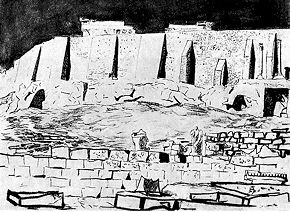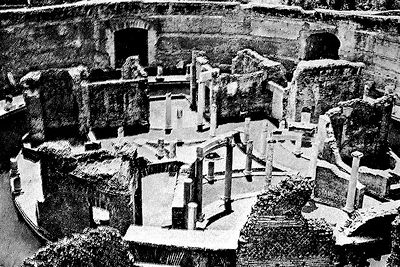Vincent Scully | Louis I. Kahn |
|
In 1950-51 other decisive events occurred. This academic year was spent by Kahn at the American Academy in Rome. That institution had been the proudest jewel of the American Beaux-Arts in its salad days. It had been founded in 1896, largely through the efforts of Charles Follen McKim, who was eventually able to elicit the financial support of J. P. Morgan for the project. To it had come several generations of Prix de Rome winners; and architects, painters, sculptors, writers, musicians, classicists, archaeologists, and art historians had all dined in varying degrees of hostility around its single long refectory table. In its early years the Academy had clearly encouraged the kind of picturesquely archaeological design which had eventually squeezed out Sullivan and Wright and against which the Modern Movement as a whole had so firmly reacted. It therefore was, with some justice, a favorite whipping boy for that movement's historians. By 1950, under the directorship of Laurance Roberts, the climate had changed. Its artists were all creatively modern artists, and its resident archaeologist, Frank E. Brown, had a wide knowledge of all architectural history and welcomed nothing so much as a fresh idea or work of art. Antiquity so came alive for those members of the Academy who had the wit to see it, and for Kahn it must have been as if a rather baggy mistress, abandoned in the bread lines, had walked youthful into the room. His sketches around the Mediterranean show the great masses of Egypt looming, the columns of Karnak, the quarries at Aswan. The buttressed wall of the Athenian Acropolis rises, and the tholos at Marmaria lies before Apollo's throne. Most of all, though no adequate drawing remains, the columns still stood at Paestum, and Kahn saw them once again. Arcuated Praeneste, the foliating Palatine, and, especially, the miraculous spaces of Hadrian's Villa at Tivoli were all seen anew with an intensity of vision the Beaux-Arts had never been able to summon up.
|
|
|
This was the case partly because a great architect and lover of the Mediterranean, Le Corbusier, had himself learned by this time how to embody its noble masses in modern constructions and programs. Kahn visited Le Corbusier's Unité d'Habitation at Marseilles while it was under construction and where, as early publications of the building had already stated, the columns of Paestum stood in their contemporary form. Soon these were to be joined by the Maisons Jaoul, first published as drawings in 1952, where a more vernacular idiom of substantial concrete lintels and solid brick walls was to be seen. Even before leaving America, Kahn, as his Psychiatric Hospital showed, had also been aware of Alvar Aalto's dormitory at M. I. T., with its strong brick masses, directly functional stair housing, and aggressive corner towers. (Kahn just missed that most splendid of all lectures, given by Aalto at Yale in 1947, when he drew the Acropolis of Athens on the blackboard and said, "In Finland in the reconstruction we shall build no temporary buildings, because not by temporary building comes Parthenon on Acropolis." Later Kahn was to say much the same thing to his expediency-minded building committees at Trenton.) Not massive, but equally expressive in a structural sense, were Mies van der Rohe's new buildings at I. I. T., where a precisely joined fabric of steel and brick defined static volumes of space with classic authority. In all these events the generally non-structural, thin wall-planed, rather pictorial phase of the twenties and thirties was being brought to a close and the principles of modern architecture were, in that sense, approaching those which Kahn had learned from the Beaux-Arts.
|
|
|
www.quondam.com/40/4003f.htm | Quondam © 2015.01.11 |








